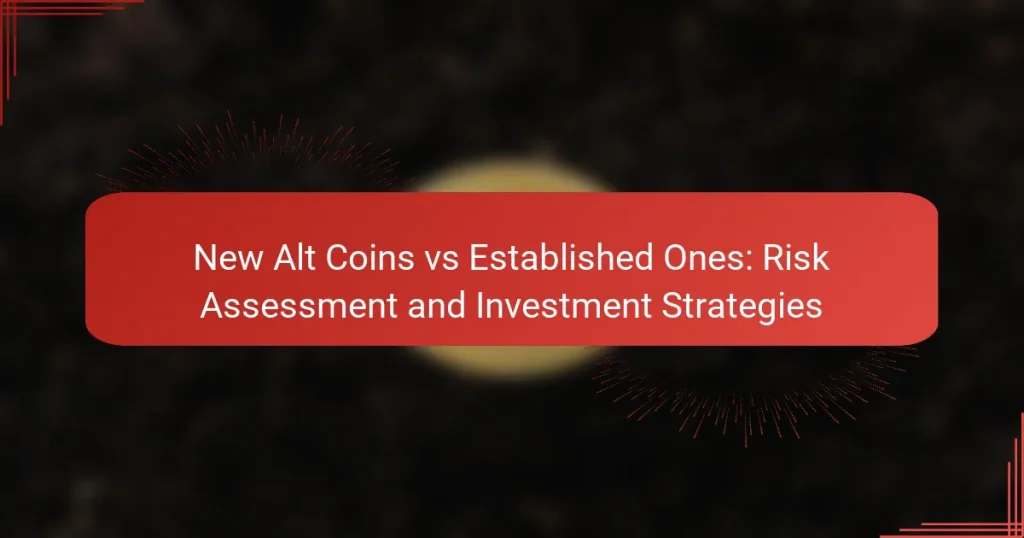Investing in new altcoins presents unique challenges, as they often come with heightened volatility and regulatory uncertainties compared to established cryptocurrencies. To navigate these risks effectively, investors should adopt strategic approaches such as diversification and thorough research, while also staying informed about market trends. In contrast, established altcoins offer a more stable investment environment due to their proven track record and strong community support.

What are the risks of investing in new altcoins compared to established ones?
Investing in new altcoins carries higher risks compared to established cryptocurrencies due to factors like volatility, regulatory uncertainties, and market adoption challenges. Understanding these risks is crucial for making informed investment decisions.
Higher volatility in new altcoins
New altcoins often experience significant price fluctuations, making them more volatile than established cryptocurrencies like Bitcoin or Ethereum. This volatility can lead to rapid gains but also steep losses, which can be challenging for investors.
For instance, a new altcoin might surge by 200% in a week, only to drop by 50% shortly after. Investors should be prepared for these swings and consider their risk tolerance before investing.
Regulatory uncertainties for new projects
New altcoins may face regulatory scrutiny that established cryptocurrencies have already navigated. This uncertainty can impact the coin’s legality, trading status, and overall market acceptance.
For example, a new project could be classified as a security by regulators, leading to restrictions on its sale. Investors should stay informed about the regulatory landscape in their country to mitigate potential risks.
Market adoption challenges for new altcoins
New altcoins often struggle to gain traction in a crowded market dominated by established players. Without a solid user base or real-world application, these coins may fail to achieve significant market adoption.
Investors should evaluate the project’s utility and community support before investing. A strong use case and active development team can indicate better chances for future success.
Security risks in new blockchain technologies
New altcoins may utilize untested blockchain technologies, which can introduce security vulnerabilities. Established cryptocurrencies have undergone extensive testing and have proven security measures in place.
Investors should research the technology behind a new altcoin and look for audits or security assessments. A lack of transparency in security practices can be a red flag.
Liquidity issues with new altcoins
Liquidity refers to how easily an asset can be bought or sold without affecting its price. New altcoins often have lower liquidity, making it difficult to execute trades without significant price changes.
Investors should be cautious when trading new altcoins, especially in large volumes. Checking trading volumes on exchanges can help gauge liquidity levels and avoid potential losses from slippage.

What investment strategies should be used for new altcoins?
Investing in new altcoins requires a strategic approach to manage risks effectively. Key strategies include diversification, thorough research, setting clear goals, utilizing dollar-cost averaging, and staying updated on market trends.
Diversification across multiple altcoins
Diversification is crucial when investing in new altcoins, as it helps mitigate risks associated with individual coins. By spreading investments across several altcoins, you can reduce the impact of a poor-performing asset on your overall portfolio.
A practical approach is to allocate funds to a mix of established and emerging altcoins, aiming for a balanced exposure. Consider investing in at least five to ten different altcoins to achieve meaningful diversification.
Conducting thorough research on new projects
Before investing in new altcoins, conduct comprehensive research to understand the project’s fundamentals. Look into the team behind the project, their experience, the technology being used, and the problem the coin aims to solve.
Utilize resources such as whitepapers, community forums, and social media channels to gather insights. Pay attention to the project’s roadmap and any partnerships that may enhance its credibility and potential for growth.
Setting clear investment goals and limits
Establishing clear investment goals is essential for guiding your strategy with new altcoins. Define what you want to achieve, whether it’s short-term gains or long-term holding, and set specific targets for returns.
Additionally, set limits on how much you are willing to invest or lose in each altcoin. This helps prevent emotional decision-making and encourages disciplined trading practices.
Utilizing dollar-cost averaging
Dollar-cost averaging (DCA) is an effective strategy for investing in new altcoins by spreading out your purchases over time. This approach reduces the impact of volatility and allows you to buy more coins when prices are low and fewer when prices are high.
Consider investing a fixed amount regularly, such as monthly or quarterly, to build your position gradually. This method can help you avoid the pitfalls of trying to time the market.
Monitoring market trends and news
Staying informed about market trends and news is vital for making timely investment decisions in the altcoin space. Follow reputable cryptocurrency news outlets, social media influencers, and market analysis platforms to keep up with developments.
Pay attention to regulatory changes, technological advancements, and market sentiment, as these factors can significantly impact the performance of new altcoins. Regularly reviewing your investments in light of new information can help you adjust your strategy as needed.

How do established altcoins mitigate investment risks?
Established altcoins reduce investment risks through various mechanisms that enhance stability and reliability. These coins typically have a proven history, robust community backing, and established partnerships, all of which contribute to a more secure investment environment.
Proven track record of performance
Established altcoins often demonstrate a consistent performance history, which can provide investors with confidence. For instance, coins like Ethereum and Litecoin have shown resilience during market fluctuations, often recovering faster than newer alternatives.
Investors should analyze historical price trends and volatility patterns to gauge the reliability of an altcoin. A coin with a stable price trajectory over several years may indicate lower risk compared to newer, untested options.
Strong community and developer support
A vibrant community and active developer involvement are critical for the longevity of an altcoin. Established coins typically have large user bases that contribute to ongoing development and innovation, which can enhance their value and utility.
For example, communities around established altcoins often engage in forums and social media, providing support and sharing insights. This collective knowledge can help investors make informed decisions and identify potential issues early.
Established partnerships and use cases
Partnerships with reputable companies and real-world use cases significantly bolster the credibility of established altcoins. These collaborations often lead to increased adoption and practical applications, which can drive demand and stabilize prices.
For instance, coins that have integrated with payment processors or e-commerce platforms are more likely to see sustained interest and usage, reducing the risk associated with speculative investments.
Regulatory compliance and transparency
Established altcoins often adhere to regulatory standards, which can mitigate legal risks for investors. Compliance with regulations helps ensure that the coin operates within legal frameworks, reducing the likelihood of sudden market disruptions due to legal issues.
Investors should look for altcoins that provide clear information about their compliance efforts and governance structures. Transparency in operations and financial reporting can further enhance trust and reduce perceived risks.
Higher liquidity in established altcoins
Higher liquidity in established altcoins allows for easier buying and selling, which can minimize the impact of price fluctuations. Coins with significant trading volumes enable investors to enter or exit positions without significantly affecting the market price.
When considering an investment, check the trading volume and liquidity of the altcoin. Established coins typically have higher liquidity, making them a safer choice for those looking to manage their investment risks effectively.

What criteria should investors consider when choosing between new and established altcoins?
Investors should evaluate market capitalization, trading volume, and the underlying technology when deciding between new and established altcoins. These factors can significantly influence the potential risks and rewards associated with each type of coin.
Market capitalization and trading volume
Market capitalization reflects the total value of a cryptocurrency and can indicate its stability. Established altcoins typically have higher market caps, which may suggest lower volatility compared to new coins that often have smaller market caps and can experience rapid price fluctuations.
Trading volume is another critical metric, as it shows how actively a coin is being bought and sold. High trading volumes in established coins can lead to better liquidity, making it easier to enter or exit positions without significant price impacts. In contrast, low trading volumes in new altcoins can result in slippage and difficulty in executing trades.
Technology and innovation behind the coin
The technology and innovation of a cryptocurrency can greatly affect its long-term viability. Established altcoins often have proven technology and a track record of successful implementation, while new altcoins may offer innovative features or solutions to existing problems but come with untested risks.
When assessing technology, consider factors such as scalability, security, and community support. Established coins like Ethereum have robust ecosystems and developer communities, while new coins may lack these essential elements, making them riskier investments. Always research the whitepapers and technical documentation to understand the potential and limitations of each coin.


